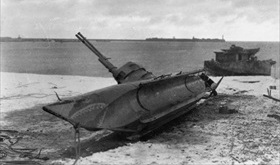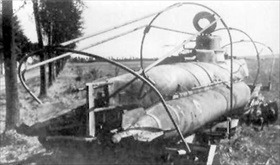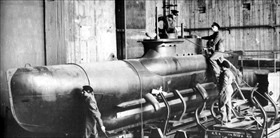GERMANY TO BUILD 2-MAN SUB
Berlin, Germany • January 18, 1944
On this date in 1944 Grand Admiral Karl Doenitz approached his commander in chief, Adolf Hitler, with a design for a new midget submarine, much larger than the one‑man Biber (Beaver) sub that was in the prototype stage. The Hecht (Pike) was a three‑man midget based on a British X-class submarine that had to be towed to its intended area of operations by a full-size “mother” sub. The Hecht was powered initially by a 12 hp torpedo motor (later versions had a diesel engine for surface use and an electric motor for underwater use), had a range of 40 nautical miles submerged, and carried one hull-mounted torpedo or one mine. Fifty-three Hechts were built between May and August 1944, but their unsatisfactory performance (Hechts had no ballast tanks) prevented their seeing action. The two-man Seehund (Seal), a derivative of the Hecht, proved superior in every way. Enthusiasm for the Seehund was so high that most of the contracts and hull numbers were allocated even before the design was completed. One thousand of these midget subs were ordered. However, due to labor and transportation problems, shortages of raw material, and conflicting priorities in Germany’s faltering economy no more than 285 were completed before the war ended. Which was fortunate. Compared to its predecessor, the Seehund had one‑third more range and carried twice the armament. It was, in effect, a miniature fleet submarine and handled well on the surface, where its small size made it very hard to detect both visually and on radar. Also, it could crash-dive in less than five seconds, and its quiet engine made it difficult to detect underwater. From January to April 1945 Seehunde performed over 140 sorties, during which they sank 8 ships for 17,301 tons and damaged 3 for 18,384 tons. Although their toll on merchant shipping was not terribly great, their sorties forced the Royal Navy to deploy about 500 escort vessels and more than 1,000 aircraft to counter their operations. Their last two sorties were almost comical; namely, resupplying the besieged German base on the French coast at Dunkirk with food rations carried inside so-called “butter torpedoes,” which they blasted up the beach.
[amazon_carousel widget_type=”ASINList” width=”600″ height=”200″ title=”Recommended Reading” market_place=”US” shuffle_products=”False” show_border=”False” asin=”1861762798,0304354546,1840675217,0304361208,1844154408,1904687962,030681160X,1849081735,0760310262,1557505101″ /]
Kriegsmarine Midget Submarines
 |  |
Right: The one-man, 6.5-ton Biber was the smallest submarine, at 29 ft long, in the Kriegsmarine. Powered alternately by an off-the-shelf gasoline motor (surface) and an electric torpedo motor (submerged), the Biber had been hastily developed to help meet the impending threat of the Allied invasion of Europe. Due to technical flaws, a tiny periscope with a limited field of view, handling difficulties, and rushed training of crews, the crude submarine never posed a threat to Allied shipping.
![]()
Left: A damaged and abandoned Biber on its transportation trailer, 1945. Armed with two externally mounted 21‑in torpedoes, two mines, or one of each, over 300 Bibers were delivered to the Kriegsmarine.
 |  |
Left: A far more successful undersea weapon than the Biber was the two-man Seehund (pl., Seehunde). At 39 ft long, the Seehund had a submerged speed of 7 knots (under 8 mph), dual propulsion diesel (surfaced) and electric (submerged) motors, and a range of 270 or so nautical miles. From January to April 1945, Seehunde performed 142 sorties, during which they sank eight ships (versus one sinking for the Biber) for a total of 17,301 tons and damaged three for a total of 18,384 tons. They lost 35 of their own out of the 138 or so commissioned into the Kriegsmarine.
![]()
Right: The Molch (Salamander) was an 11-ton, one-man, all-electric boat designed for coastal operations. Looking like a large torpedo, the Molch had a small range (40 miles at 5 knots), traveled submerged, and carried two underslung torpedoes. A total of 393 such boats were delivered to the Kriegsmarine. The Molch was used in the Mediterranean against the Allied invasion of the south of France (Operation Dragoon). On the night of September 25/26, 1944, a flotilla of 12 neither sank nor damaged anything for the loss of 10 subs. The last two subs were destroyed in Allied warship bombardment of San Remo, Italy, shortly thereafter.
German Midget Submarines of World War II: Molch, Biber, and Seehund
![]()

 History buffs, there is good news! The Daily Chronicles of World War II is now available as an ebook for $4.99 on Amazon.com. Containing a year’s worth of dated entries from this website, the ebook brings the story of this tumultuous era to life in a compelling, authoritative, and succinct manner. Featuring inventive navigation aids, the ebook enables readers to instantly move forward or backward by month and date to different dated entries. Simple and elegant! Click
History buffs, there is good news! The Daily Chronicles of World War II is now available as an ebook for $4.99 on Amazon.com. Containing a year’s worth of dated entries from this website, the ebook brings the story of this tumultuous era to life in a compelling, authoritative, and succinct manner. Featuring inventive navigation aids, the ebook enables readers to instantly move forward or backward by month and date to different dated entries. Simple and elegant! Click 











